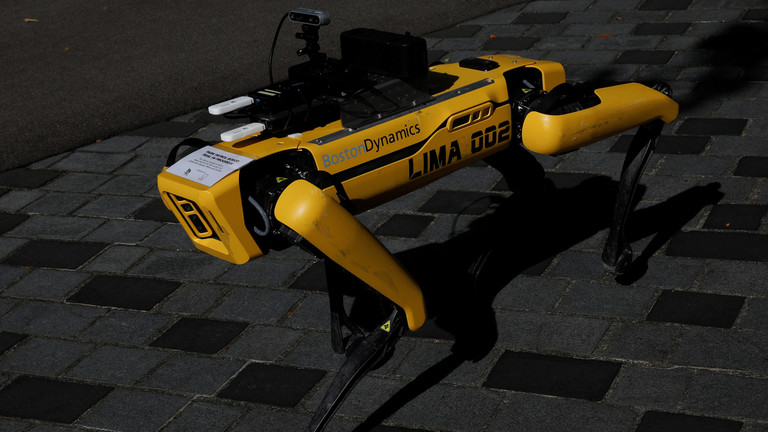Previously on “The Robot Question”: Police Now Actively Using Boston Dynamics Robot Dogs
We’re going to need to talk about the Robot Question (RQ).
There are implications here that are not being discussed at all.
RT:
Spot, the four-legged robo-canine built by Boston Dynamics, appears alongside trainee soldiers during drills carried out by a French military school, but the US firm says it had not been notified in advance about its use.
The pictures of the drill were shared earlier this week on Twitter by France’s foremost military school, the École Spéciale Militaire de Saint-Cyr in the country’s northwest. The tweet said the drill tested students’ awareness of the challenges of tomorrow, like robotization of the battlefield.
21. Je déploie le robot pour reconnaitre OSCAR3.
Retour en images sur l’exercice de recherche appliquée organisé les 30 et 31 mars par l’EMIA et le centre de recherche. Robotisation du champ de bataille : sensibiliser les élèves aux enjeux de demain. #CapaciTERRE #Robots pic.twitter.com/HiZ2BFOZPY— Saint-Cyr Coëtquidan (@SaintCyrCoet) April 6, 2021
The two-day exercise brought together 80 students with some combat experience and several robots, Spot among them. According to French media, last month’s drill re-enacted offensive action, defensive action and urban combat. The actions were performed first without robots, then with their help. The newspaper Ouest-France suggests the robotic dog was being used for reconnaissance.
“During the phase of urban combat without a robot, I was killed. But then when the robot did the reconnaissance, I wasn’t”, the newspaper quotes one of the soldiers, who went on to say that Spot didn’t prove too reliable as its battery died “in the middle of an assault”.
An executive with Boston Dynamics, Michael Perry, told technology news website The Verge that the robodog’s developer had no idea it took part in a military drill. “We’re learning about it as you are. We’re not clear on the exact scope of this engagement”. He explained that Spot was distributed in Europe by a reseller, Shark Robotics.
Boston Dynamics describes Spot as “an agile mobile robot that navigates terrain with unprecedented mobility”, which helps its users achieve results in a safer, more efficient and more predictable manner. Spot can carry up to 14 kilos of equipment and be fitted with cameras. Available for sale since last June for $74,500, it can use an artificial intelligence system to go on autonomous missions; however, it’s mostly operated by remote-control.
The company stressed that every buyer of Spot robots and other models signs a user agreement, according to which it is prohibited to use robots to harm or intimidate people or as a weapon.
Well, regrettably, that isn’t enough.
What is also regrettable is that it is now clear there is no plan to implement Isaac Asimov’s laws.
Yes, I know that Asimov was Jewish. But he is among the list of Jews that I like, and whether or not I liked him, passing a law that all robots have to be imprinted with a hard code of the three laws would have been a really good idea.
(Note on Asimov: I recently went back and read some of the Robot stories, and didn’t really think much of them – they are very much children’s stories. However, I think the Foundation series still holds up as a very good epic science fiction saga, not totally on par with Dune, but still good. Then again, it’s been a while since I’ve read them.)
Unfortunately, we never even had this discussion, and it is now too late to have this discussion. Furthermore, Asimov was writing in the 1940s, without knowledge of modern computer coding. I don’t actually think there would be a way to hard-code all robots with these laws, it would be up to the individual designers of proprietary software. Virtually all of the complexities of development of robots are not in the software at all, but the hardware. (The software can literally just be pulled from AI already developed for video games.)
Therefore: just as you can “jailbreak” an iPhone and make it so you can install your own software and even make some modifications to Apple’s proprietary software, people could “jailbreak” these robots and modify the software to make them capable of murder.
But, again: what is incredible is that we never had the discussion. Asimov’s goal was not necessarily related to the details of how a robot is programmed. His goal was to lay out a framework for the public discussion, long before robots became a reality. But we just skipped over this, just as we’ve skipped over the larger implications of all modern technology.
I recently wrote about how we skipped over deep fakes: What are They Going to Do About Deep Fakes?
We have yet to have a discussion about the sociological impact of the smartphone, even as we are over a decade into the process of these devices disrupting our social lives.
Ted Kaczynski – the Unabomber – wrote a manifesto about the dangers of technology. This was of major interest to me before I ever figured out the issue of race, and many of the other issues that have become pillars of this website. Kaczynski based his manifesto on the work of a French sociologist named Jaques Ellul.
Most of you probably won’t want to read Ellul. It is extremely difficult material. However, I did read it during a period in the late 00s, when I was in my mid twenties and going through a very difficult process of working out my personal belief system. (I cut connection to the internet for a period in order to read books exclusively.)
The two books are called (in English) “The Technological Society” and “The Technological System.” He also wrote another book I read, which is not exactly on this topic but is related (and is much easier to read) called “Propaganda.” All of these books are available on Library Genesis, for those who want to go into that.
Everyone else should simply read the Kaczynski manifesto, which I have published here on the site.
By the way, I’m against violence, etc., etc., etc. as everyone knows, but for those who don’t know the story: Ted was doing these bombings in order to draw attention to the issue of the development of technology, and the effect that it was going to have on society. He has probably one of the highest IQs of anyone on earth. However, he was also an MK Ultra victim, having been put through mind control experiments during college.
(I should also note, for those of you who are hardcore book readers, that Bertrand Russell’s “The Impact of Science on Society” is an older and less critical approach to technological advancement, which can be read alongside Aldous Huxley’s “Brave New World.”)
Technology is the defining issue of our age, even more so than the Jewish Question. The Jewish Question is only such a big question because of technology – before industrialization and full urbanization, Jews were primarily a nuisance, rather than an existential threat. They had the capacity to become an existential threat only in the same way that rats had the capacity to go from nuisance to an existential threat during the black plague (i.e., under very specific circumstances).
Reasoned regulation and direction of technology is something that is utterly incompatible with the democracy system – whether it is the traditional utopian notion of democracy or the modern callous and totalitarian conception of it. In order to have a proper discussion of regulating the effects of science on society, you would have to have a government that was run with minimal levels of corruption (something that is impossible in democracy), and you would have to have the ability to enforce edicts that overrode economic interests in favor of social interests.
Ironically, you would have to have a science-based society. That is ironic because this current voodoo-oriented totalitarian ideology is claiming to be a science-based society.
A real science-based society would operate on statistics, rather than pseudo-religious metaphysical assertions. Everything about modern society is rooted in rootless metaphysical assertions, which always trump statistics, to the point where statistics are condemned as fascism and racial or sexual hatred.
Therefore, we are hurtling headlong into a technological apocalypse (technopocalypse).
Killer robots are nigh the least of our concerns here, frankly. The first concern presently is what exactly is going on with this vaccine, then the secondary concern is what effect electromagnetic pollution is having on our brains (with 5G this becomes a very serious issue of concern, but I think it’s clear that the current levels are affecting our ability to think clearly, to concentrate). Presumably the third concern would be the cellphones themselves, and what this is doing to people psychologically. I don’t think the current situation and associated scenarios would be possible without the cellphones, frankly, so maybe that should be the first issue. With the cellphones, people have disconnected totally from physical reality, which has opened up all of these bizarre possibilities.
The “good news” is that it is clear that the reality-tunnel of the elite has been horribly and irreconcilably transformed as well, which is going to lead to a collapse of the system before these technologies are ever fully implemented.
However, before the collapse, we probably will have killer robots stalking us, so that is probably something people want to think about.
I read a lot of science fiction and play a lot of science fiction games, and clearly, traditional bullets do not work on robots. I think the best way to handle a robot attack would be to wait for it to run out of ammo, and then use melee weaponry against it. Probably, a “crushing” form of melee, such as a sledgehammer.
Wasteland 3 was the best game of 2020, and killing killer robots was a big issue in the game, as most of the enemies were organic, so most weapons builds were based around killing organic enemies – i.e., traditional bullets.
The game also features a mechanics skill that can be used to hack robots. I think hacking killer robots will be something that is possible in the real world future we are looking at, as they are going to have to be WiFi enabled, and governments tend to be very bad with security. Furthermore, the software they run on is going to be complicated enough that there will be a lot of potential exploits.
The game of the year in 2021 (because it wasn’t released on Steam until then) thus far is Phoenix Point, which is also a game with mainly organic enemies but the occasional robot. That game does not have a hacking skill (at least not for the larger AI enemies), so you use melee almost exclusively.
However, in Phoenix Point, the processing center of the robots (who are actually cyborgs who have replaced their entire bodies with mechanical modifications) is the head, so high caliber armor-piercing sniper shots to the head kill them. I do not think that the processing center of the coming real life killer robots will be in an identifiable head, but there may be a way to use armor-piercing ammo to take out some key component of the robot from a distance.
I don’t know enough to known, but it would be more likely that you would target the battery than anything else, as it would be very easy to have redundancy of processing power, with microchips implanted throughout the robot. The sensor modules are definitely going to be redundant, so they will have total 360 vision, even if you’re able to shoot off parts of them.
 Daily Stormer The Most Censored Publication in History
Daily Stormer The Most Censored Publication in History













